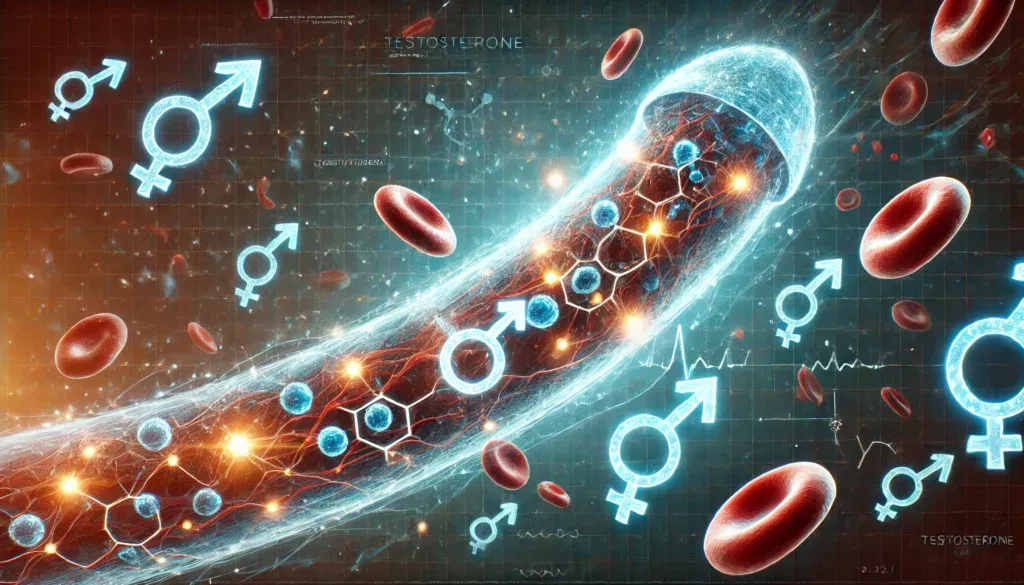Testosterone is a crucial hormone that plays a vital role in a variety of physiological functions, particularly in men’s health. Measuring testosterone levels is essential for diagnosing and managing conditions such as hypogonadism, infertility, and hormonal imbalances. However, interpreting testosterone blood test results can be confusing due to the array of abbreviations and markers involved. Understanding these testosterone blood test abbreviations is critical for making informed decisions about health and treatment options.
You may also like: How to Get Your Testosterone Levels Checked: Best At-Home and Lab Testing Options
The Importance of Testosterone Testing
Testosterone is the primary androgen responsible for regulating muscle mass, bone density, libido, and overall vitality. It also influences mood, energy levels, and cognitive function. A testosterone blood test is commonly ordered to evaluate symptoms such as fatigue, erectile dysfunction, and decreased muscle mass. Physicians may also use these tests to monitor testosterone replacement therapy (TRT) or to diagnose underlying medical conditions affecting hormonal balance. Interpreting these test results requires familiarity with key abbreviations and their significance.
Many different markers can be assessed in a testosterone blood test, each providing unique insights into hormonal health. The most common include total testosterone (TT), free testosterone (FT), bioavailable testosterone (BT), and sex hormone-binding globulin (SHBG). Additionally, other related markers such as luteinizing hormone (LH) and follicle-stimulating hormone (FSH) provide further context in evaluating testosterone production and overall endocrine function.

Understanding Total Testosterone (TT)
Total testosterone (TT) represents the overall amount of testosterone circulating in the bloodstream, including both protein-bound and free forms. This measurement is crucial in evaluating overall testosterone levels, though it does not necessarily reflect the amount of testosterone that is biologically available for the body’s use. Total testosterone levels can vary based on age, time of day, and individual health status. Morning levels tend to be highest, as testosterone follows a diurnal rhythm.
A low total testosterone level may indicate hypogonadism, a condition in which the testes do not produce enough testosterone. This can result in symptoms such as decreased libido, muscle weakness, and mood disturbances. Elevated levels, though less common, may be associated with conditions such as androgen-secreting tumors or steroid use. Interpreting total testosterone levels in conjunction with other markers provides a more complete picture of hormonal health.
Free Testosterone (FT) and Its Role in Hormonal Health
Free testosterone (FT) refers to the fraction of testosterone that is unbound and readily available for cellular activity. Unlike total testosterone, free testosterone is not attached to proteins such as SHBG or albumin, making it the most active form of the hormone. Free testosterone levels are often measured to provide additional insights when total testosterone levels appear normal, yet symptoms of testosterone deficiency persist.
Low free testosterone levels can occur even when total testosterone levels are within the reference range. This is especially true in cases where SHBG levels are elevated, reducing the proportion of free testosterone available for physiological functions. Conversely, individuals with low SHBG levels may have higher free testosterone levels despite having average or low total testosterone readings.
Bioavailable Testosterone (BT) and Its Clinical Significance
Bioavailable testosterone (BT) includes both free testosterone and testosterone loosely bound to albumin. Unlike testosterone that is tightly bound to SHBG, bioavailable testosterone remains accessible to tissues and can exert biological effects. Measuring bioavailable testosterone can be particularly useful in assessing testosterone status in men with conditions that alter SHBG levels, such as obesity, diabetes, or liver disease.
A low bioavailable testosterone level may contribute to symptoms of low testosterone, including reduced energy, diminished strength, and cognitive decline. Clinicians often consider bioavailable testosterone as a better indicator of androgen activity than total testosterone alone. This marker is also relevant in evaluating hormonal balance in aging men, as SHBG levels tend to increase with age, reducing bioavailable testosterone.
The Role of Sex Hormone-Binding Globulin (SHBG) in Testosterone Regulation
Sex hormone-binding globulin (SHBG) is a glycoprotein that binds to sex hormones, including testosterone, dihydrotestosterone (DHT), and estrogen. By binding to testosterone, SHBG regulates the amount of free and bioavailable testosterone in circulation. Higher SHBG levels result in lower free testosterone availability, while lower SHBG levels can increase the proportion of free testosterone.
SHBG levels can be influenced by factors such as age, obesity, insulin resistance, and liver function. Elevated SHBG levels are commonly seen in conditions such as hyperthyroidism and liver disease, while lower levels may be associated with metabolic disorders such as type 2 diabetes. Because SHBG plays a significant role in testosterone bioavailability, measuring it alongside total and free testosterone provides a more comprehensive assessment of androgen status.
Luteinizing Hormone (LH) and Its Impact on Testosterone Production
Luteinizing hormone (LH) is a pituitary hormone that stimulates the testes to produce testosterone. Measuring LH levels alongside testosterone can help distinguish between primary and secondary causes of testosterone deficiency. Primary hypogonadism, which originates in the testes, is characterized by low testosterone levels with elevated LH, indicating that the testes are not responding appropriately to stimulation. In contrast, secondary hypogonadism, which arises from dysfunction in the hypothalamus or pituitary gland, presents with both low testosterone and low or inappropriately normal LH levels.
Abnormal LH levels may indicate underlying conditions such as pituitary disorders, genetic conditions like Klinefelter syndrome, or the effects of certain medications. Evaluating LH levels provides valuable context in diagnosing and managing testosterone-related disorders.
Follicle-Stimulating Hormone (FSH) and Its Relationship to Testosterone
Follicle-stimulating hormone (FSH) is another pituitary hormone involved in the regulation of reproductive function. While its primary role is in spermatogenesis, FSH levels can also provide insights into testicular function. Elevated FSH levels in the presence of low testosterone may suggest primary testicular failure, while low FSH levels in conjunction with low testosterone may indicate secondary hypogonadism.
Measuring FSH alongside testosterone and LH can be particularly useful in cases of infertility evaluation or unexplained low testosterone levels. Understanding these hormonal interactions helps in diagnosing and managing conditions affecting testosterone production and reproductive health.
Prolactin and Its Influence on Testosterone Levels
Prolactin is a hormone produced by the pituitary gland that can impact testosterone production when present in excessive amounts. Elevated prolactin levels, a condition known as hyperprolactinemia, can suppress gonadotropin-releasing hormone (GnRH), leading to reduced LH and FSH secretion and subsequently lower testosterone levels. This can result in symptoms such as reduced libido, erectile dysfunction, and infertility.
Causes of elevated prolactin levels include pituitary tumors (prolactinomas), medications such as antipsychotics and antidepressants, and hypothyroidism. Measuring prolactin levels in men with unexplained low testosterone can help identify underlying causes that require specific treatment approaches.

Frequently Asked Questions (FAQ) on Testosterone Blood Test Abbreviations
1. Why are testosterone blood test abbreviations important in medical diagnostics?
Testosterone blood test abbreviations are crucial for understanding lab results quickly and accurately. These abbreviations help medical professionals communicate efficiently and ensure that patients receive the correct interpretation of their hormone levels. For example, abbreviations like TT (Total Testosterone) and FT (Free Testosterone) distinguish different testosterone components that play unique roles in the body. Misinterpretation of these abbreviations can lead to incorrect conclusions about hormone health. Therefore, learning common testosterone blood test abbreviations can empower patients to have more informed discussions with their healthcare providers.
2. What is the difference between TT and FT in testosterone tests?
TT (Total Testosterone) represents the overall testosterone circulating in the blood, including both bound and unbound forms. FT (Free Testosterone), on the other hand, measures only the unbound testosterone available for the body to use. The distinction is vital because bound testosterone, often attached to proteins like SHBG (Sex Hormone-Binding Globulin), is not readily available for biological activity. Many symptoms of low testosterone may stem from low free testosterone rather than total testosterone. This is why understanding testosterone blood test abbreviations can help in evaluating both overall and bioavailable testosterone levels.
3. How does SHBG affect testosterone levels, and why is it included in tests?
SHBG (Sex Hormone-Binding Globulin) plays a crucial role in regulating how much testosterone is freely available in the bloodstream. Higher SHBG levels mean less free testosterone, potentially leading to symptoms of testosterone deficiency despite normal total testosterone levels. Some individuals with high SHBG may appear to have adequate total testosterone but still experience fatigue, reduced muscle mass, and decreased libido. The abbreviation for testosterone levels should always be considered in the context of SHBG to get a more accurate assessment of hormone balance. This is why some lab panels include both SHBG and free testosterone for a comprehensive evaluation.
4. What does Bioavailable Testosterone (BT) measure, and why is it significant?
Bioavailable Testosterone (BT) includes free testosterone and testosterone loosely bound to albumin, making it a more accurate indicator of the hormone’s active form in the body. Unlike total testosterone, which includes tightly bound testosterone that is not readily available, bioavailable testosterone provides a clearer picture of hormonal function. Many endocrinologists prioritize this measurement when diagnosing conditions like hypogonadism or evaluating symptoms of low testosterone. Since bioavailable testosterone reflects a person’s actual hormonal activity, it is an essential factor in interpreting testosterone blood test abbreviations. This test is particularly useful for men experiencing symptoms despite normal total testosterone levels.
5. Are testosterone blood test abbreviations standardized across all labs?
While many abbreviations for testosterone are commonly used, there can be slight variations in terminology across different laboratories. For example, some labs may use T for total testosterone instead of TT, or FT for free testosterone, while others may differentiate between direct and calculated free testosterone. This lack of standardization can sometimes cause confusion when comparing results from different medical providers. Patients should always request clarification from their doctor if they encounter unfamiliar testosterone blood test abbreviations. Keeping a record of past test results and understanding the context of each abbreviation can help track hormone levels accurately over time.
6. How do age and health conditions impact testosterone test results?
Testosterone levels naturally decline with age, which is why age-specific reference ranges are often used in medical assessments. Certain health conditions, such as obesity, diabetes, and chronic stress, can also influence testosterone levels by affecting hormone production and metabolism. The abbreviation for testosterone in test results should always be interpreted in relation to a patient’s overall health and lifestyle factors. In some cases, additional tests measuring luteinizing hormone (LH) and follicle-stimulating hormone (FSH) are needed to determine whether testosterone decline is due to primary or secondary hypogonadism. Understanding how external factors influence test results can help individuals take proactive steps in managing their hormone health.
7. Can lifestyle changes affect testosterone levels, and how should they be monitored?
Yes, lifestyle changes such as improved diet, regular exercise, and stress management can significantly impact testosterone levels. Strength training and high-intensity interval training (HIIT) have been shown to boost testosterone production naturally. Reducing processed foods and incorporating healthy fats can also support hormone balance. When tracking progress, patients should familiarize themselves with testosterone blood test abbreviations to interpret changes in their lab results effectively. Routine testing at consistent times of the day, preferably in the morning, ensures more accurate comparisons over time.
8. What are the limitations of at-home testosterone test kits?
At-home testosterone test kits offer convenience, but they may not provide the same accuracy as lab-based tests. Many of these kits measure only total testosterone and do not assess free testosterone or SHBG levels, limiting their diagnostic usefulness. Additionally, variations in sample collection, storage, and processing can impact reliability. People using these kits should understand the abbreviation for testosterone and its implications in the context of overall hormone health. For a comprehensive assessment, follow-up testing at a medical facility is recommended.
9. How often should testosterone levels be tested, and what factors influence frequency?
The frequency of testosterone testing depends on an individual’s symptoms, medical history, and whether they are undergoing testosterone replacement therapy (TRT). Men with persistent symptoms of low testosterone should consider testing at least annually, while those on TRT may need monitoring every three to six months. Factors like lifestyle changes, weight loss, or the onset of new symptoms may warrant additional testing. Understanding testosterone blood test abbreviations allows for better tracking of trends over time. Regular testing helps ensure that treatment plans are adjusted appropriately based on objective hormone levels.
10. Can testosterone tests detect hormonal imbalances in women?
Yes, testosterone testing is not just for men—women also require balanced testosterone levels for overall health. Low testosterone in women can contribute to fatigue, mood disturbances, and reduced muscle strength, while high levels may indicate conditions like polycystic ovary syndrome (PCOS). Because hormone levels fluctuate throughout the menstrual cycle, test timing is essential for accurate results. Learning testosterone blood test abbreviations can help women understand their results and discuss appropriate treatment options with their doctor. A comprehensive hormone panel, including estrogen and progesterone, may be necessary for a complete hormonal assessment.

Conclusion: The Role of Dihydrotestosterone (DHT) in Androgenic Activity
Dihydrotestosterone (DHT) is a potent androgen derived from testosterone via the action of the enzyme 5-alpha reductase. DHT plays a crucial role in the development of male secondary sexual characteristics, prostate growth, and hair follicle regulation. While testosterone is the primary androgen in circulation, DHT exerts stronger androgenic effects at the tissue level.
Abnormal DHT levels can be associated with conditions such as androgenetic alopecia (male pattern baldness), benign prostatic hyperplasia (BPH), and certain prostate disorders. Monitoring DHT levels may be useful in cases where testosterone therapy is being considered, as excessive DHT conversion can lead to unwanted side effects such as hair loss or prostate enlargement.
testosterone testing guide, hormone blood test abbreviations, testosterone lab markers, interpreting testosterone results, SHBG and testosterone, free testosterone meaning, total testosterone levels, testosterone deficiency diagnosis, men’s health hormone panel, endocrine function assessment,hormone imbalance symptoms, testosterone replacement therapy, low testosterone treatment, male hormone levels, blood test for testosterone, androgen deficiency, TRT monitoring, hormonal health assessment, endocrine disorders, testosterone production
Further Reading:
Disclaimer: The information provided in this article is for general informational purposes only. The content does not constitute professional advice of any kind, including but not limited to medical, legal, or financial advice. HisHealthMag and its contributors make no representations or warranties regarding the accuracy, completeness, or reliability of the information presented. Always seek the advice of a qualified professional for any specific concerns or questions you may have. Neither HisHealthMag nor its authors assume any responsibility or liability for any actions taken based on the information provided in this article. The views and opinions expressed are those of the author(s) and do not necessarily reflect the official policy or position of HisHealthMag.





